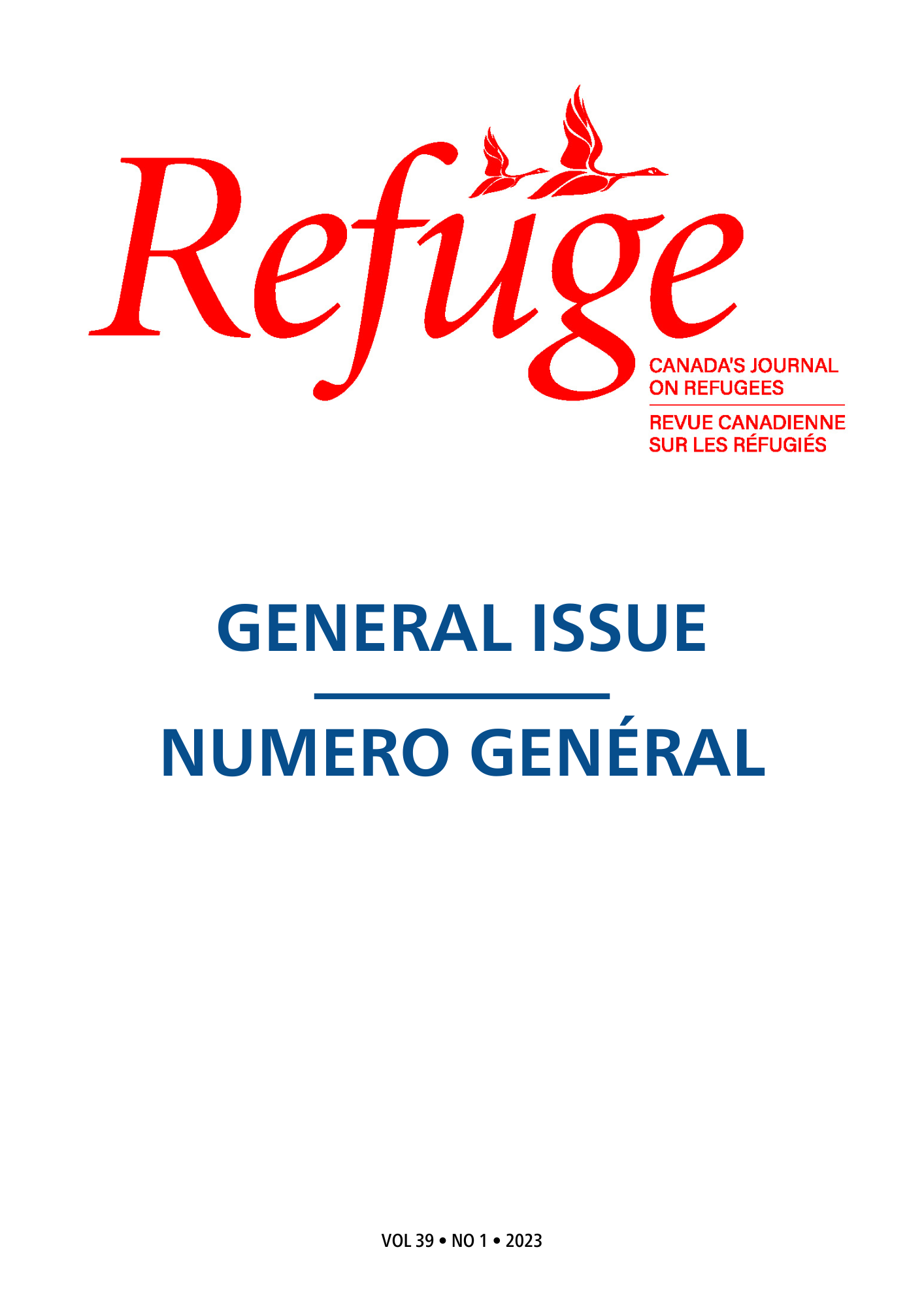Health Literacy and Refugee Women During the COVID-19 Pandemic
Outlooks for ESL Classes
DOI:
https://doi.org/10.25071/1920-7336.40903Keywords:
refugee women, health literacy, English as a Second Language, ESL, COVID-19Abstract
During the COVID-19 pandemic, refugee women in the United States faced significant challenges to sustain their livelihoods, such as losing jobs and health care, becoming essential workers, and finding oneself again in unprecedented situations of limited mobility. These impacts reflect dynamics in migrant health literacy including language proficiency (skills-based approaches) as well as experiences, identities, and power relations in society (socio-cultural approaches). In this article, I explore these dynamics through a gender perspective with a focus on intra-familial health brokering, empowerment-based health education, and health information mapping by drawing on ethnographic research from Portland, Oregon. This includes interviews with 15 refugee women and representatives of organizations working in the context of migration as well as observations of service-providing community efforts. My interviews and observations demonstrate that disruptions in language learning, socio-cultural barriers, and limited access to health-related information resources have posed significant challenges to refugee women’s livelihoods during the pandemic. I suggest that English as a Second Language (ESL) classes can be imperative in addressing these challenges as the classes provide a space for language learning, intercultural dialogue, and information sharing in gender-responsive ways.
Metrics
References
Andrews, M. M., & Boyle, J. S. (2008). Transcultural concepts in nursing care. Wolters Kluwer/Lippincott, Williams & Wilkins.
Andrulis, D., & Brach, C. (2007). Integrating literacy, culture, and language to improve health care quality for diverse populations. American Journal of Health Behavior, 31(Supp1), S122–S133. https://doi.org/10.5555/ajhb.2007.31.supp.S122
Banulescu-Bogdan, N. (2020, January). Beyond work: Reducing social isolation for refugee women and other marginalized newcomers. Transatlantic Council on Migration. https://www.migrationpolicy.org/sites/default/files/publications/TCM-Social-Isolation_FINALWEB.pdf
Barnes, D. M., Harrison, C., & Heneghan, R. (2004). Health risk and promotion behaviors in refugee populations. Journal of Health Care for the Poor and Underserved, 15(3), 347–356. https://doi.org/10.1353/hpu.2004.0034
Boyd, M., & Pikkov, D. (2005). Gendering migration, livelihood and entitlements: Migrant women in Canada and the United States. UNRISD Occasional Paper No. 6. United Nations Research Institute for Social Development (UNRISD). https://www.econstor.eu/bitstream/10419/148814/1/863099858.pdf
Bresolin, L. (1999). Health literacy: Report of the Council on Scientific Affairs. JAMA: The Journal of the American Medical Association, 281(6), 552–557. https://doi.org/10.1001/jama.281.6.552
Chao, X., & Kang, B. (2020). Health literacy among bhutanese adult refugees in the United States: The sociocultural approach. Adult Education Quarterly, 70(3), 258–276. https://doi.org/10.1177/0741713620904047
Deacon, Z., & Sullivan, C. (2009). Responding to the complex and gendered needs of refugee women. Journal of Women and Social Work, 24(3), 272–284. https://doi.org/10.1177/0886109909337401
Flores, G., Abreu, M., Brown, V., & Tomany-Korman, S. C. (2005). How Medicaid and the State Children’s Health Insurance Program can do a better job of insuring uninsured children: The perspectives of parents of uninsured Latino children. Ambulatory Pediatrics, 5(6), 332–340. https://doi.org/10.1367/A04-067R2.1
Galanti, G.-A. (2008). Caring for patients from other cultures. University of Pennsylvania Press. https://doi.org/10.9783/9780812203479
Gany, F. M., Herrera, A. P., Avallone, M., & Changrani, J. (2006). Attitudes, knowledge, and health-seeking behaviors of five immigrant minority communities in the prevention and screening of cancer: A focus group approach. Ethnicity and Health, 11(1), 19–39. https://doi.org/10.1080/13557850500391394
Gelatt, J., Batalova, J., & Capps, R. (2020, November). An early readout of the economic effects of the COVID-19 crisis. Migration Policy Institute. https://www.migrationpolicy.org/sites/default/files/publications/COVID-19-Unemployment-Women-FS-FINAL.pdf
Gelatt, J., & Capps, R. (2020, May). Barriers to COVID-19 testing and treatment: Immigrants without health coverage in the United States. Migration Policy Institute. https://www.migrationpolicy.org/research/covid-19-testing-treatment-immigrants-health-insurance
Golesorkhi, L. Z., Fortson, G., Harder, K., & Riedmann, T. (2020). Centering community in COVID-19 responses: Refugee women’s livelihoods in a global pandemic. International Journal of Sociology and Social Policy, 42(3–4), 289–297. https://doi.org/10.1108/IJSSP-07-2020-0332
Golesorkhi, L. Z., Fortson, G., & Riedmann, T. (2022). Filling the gaps: Policy mismatches, community responses, and refugee livelihoods during a global pandemic. In G. Schweiger (Ed.), Philosophical perspectives on the social consequences of the COVID-19 pandemic (pp. 291-308). Springer.
Hill, H. (2004). Health literacy is a social justice issue that affects us all. Adult Learning, 15(1–2), 4–6. https://doi.org/10.1177/104515950401500101
Im, S., & Swan, L. E. T. (2019). Qualitative exploration of critical health literacy among Afghan and Congolese refugees resettled in the USA. Health Education Journal, 78(1), 38–50. https://doi.org/10.1177/0017896918785932
Ingleby, D. (2012). Acquiring health literacy as a moral task. International Journal of Migration, Health and Social Care, 8(1), 22–31. https://doi.org/10.1108/17479891211231383
Khuu, B. P., Lee, H. Y., Zhou, A. Q., Shin, J., & Lee, R. M. (2016). Healthcare providers’ perspectives on parental health literacy and child health outcomes among Southeast Asian American immigrants and refugees. Children and Youth Services Review, 67, 220–229. https://doi.org/10.1016/j.childyouth.2016.06.006
Lloyd, A. (2014). Building information resilience: How do resettling refugees connect with health information in regional landscapes—implications for health literacy. Australian Academic & Research Libraries, 45(1), 48–66. https://doi.org/10.1080/00048623.2014.884916
Mas, F. S., Cordova, C., Murrietta, A., Jacobson, H. E., Ronquillo, F., & Helitzer, D. (2015). A multisite community-based health literacy intervention for Spanish speakers. Journal of Community Health, 40, 431–438. https://doi.org/10.1007/s10900-014-9953-4
Mas, F. S., Mein, E., Fuentes, B., Thatcher, B., & Balcázar, H. (2013). Integrating health literacy and ESL: An interdisciplinary curriculum for Hispanic immigrants. Health Promotion Practice, 14(2), 263–273. https://doi.org/10.1177/1524839912452736
Nelson-Peterman, J. L., Toof, R., Liang, S., & Grigg-Saito, D. C. (2015). Long-term refugee health: Health behaviors and outcomes of Cambodian refugee and immigrant women. Health Education & Behavior, 42(6), 814–823. https://doi.org/10.1177/1090198115590779
Nutbeam, D. (2000). Health literacy as a public health goal: A challenge for contemporary health education and communication strategies into the 21st century. Health Promotion International, 15(3), 259–267. https://doi.org/10.1093/heapro/15.3.259
Orellana, M. F., Dorner, L., & Pulido, L. (2003). Accessing assets: Immigrant youth’s work as family translators or “para-phrasers.” Social Problems, 50(4), 505–524. https://doi.org/10.1525/sp.2003.50.4.505
Papen, U. (2009). Literacy, learning and health: A social practices view of health literacy. Literacy & Numeracy Studies, 16(2), 19–34. https://doi.org/10.5130/lns.v0i0.1275
Parker, R., & Ratzan S. C. (2010). Health literacy: A second decade of distinction for Americans. Journal of Health Communication, 15(S2), 20–33. https://doi.org/10.1080/10810730.2010.501094
Perry, K. H. (2009). Genres, contexts, and literacy practices: Literacy brokering among Sudanese refugee families. Reading Research Quarterly, 44(3), 256–276. http://www.jstor.org/stable/25655455
Pignone, M., DeWalt, D. A., Sheridan, S., Berkman, N., & Lohr, K. N. (2005). Interventions to improve health outcomes for patients with low literacy. A systematic review. Journal of General Internal Medicine, 20(2), 185–192. https://doi.org/10.1111/j.1525-1497.2005.40208.x
Potocky-Tripodi, M. (2003). Refugee economic adaptation: Theory, evidence, and implications for policy and practice. Journal of Social Service Research, 30(1), 63–91. https://doi.org/10.1300/J079v30n01_04
Poureslami, I., Rootman, I., Doyle-Waters, M. M., Nimmon, L., & FitzGerald, J. M. (2011). Health literacy, language, and ethnicity-related factors in newcomer asthma patients to Canada: A qualitative study. Journal of Immigrant and Minority Health, 13(2), 315–322. https://doi.org/10.1007/s10903-010-9405-x
Purnell, L., & Paulanka, B. (2008). Transcultural health care: A culturally competent approach. F. A. Davis. https://www.fadavis.com/product/transcultural-health-care-competent-purnell
Rudd, R., Kirsch, I., & Yamamoto, K. (2004, April). Literacy and health in America: Policy information report. Educational Testing Service. https://www.ets.org/Media/Research/pdf/PICHEATH.pdf
Salant, T., & Lauderdale, D. S. (2003). Measuring culture: A critical review of acculturation and health in Asian immigrant populations. Social Science and Medicine, 57(1), 71–90. https://doi.org/10.1016/s0277-9536(02)00300-3
Santos, G., Gorukanti, A. L., Jurkunas, L .M., & Handley, M. A. (2018). The health literacy of US immigrant adolescents: A neglected research priority in a changing world. International Journal of Environmental Research and Public Health, 15(10), Article 2108. https://doi.org/10.3390/ijerph15102108
Selden, C. R., Zorn, M., Ratzan, S. C., & Parker, R. M. (Eds.). (2000). National Library of Medicine current bibliographies in medicine: Health literacy. National Institutes of Health, US Department of Health and Human Services. https://www.researchgate.net/publication/230877250_National_Library_of_Medicine_Current_Bibliographies_in_Medicine_Health_Literacy
Shaw, S. J., Huebner, C., Armin, J., Orzech, K., & Vivian, J. (2008). The role of culture in health literacy and chronic disease screening and management. Journal of Immigrant and Minority Health, 11(6), 460–467. https://doi.org/10.1007/s10903-008-9135-5
Singleton, K. (2002, February). Health literacy and adult English learner. National Center for ESL Literacy Education. https://www.govinfo.gov/content/pkg/ERIC-ED465309/pdf/ERIC-ED465309.pdf
Singleton, K., & Krause, E. (2009). Understanding cultural and linguistic barriers to health literacy. OJIN: The Online Journal of Issues in Nursing, 14(3), Article 4. https://doi.org/10.3912/OJIN.Vol14No03Man04
Sørensen, K., Van den Broucke, S., Fullam, J., Doyle, G., Pelikan, J., Slonska, Z., Brand, H., & (HLS-EU) Consortium Health Literacy Project European. (2012). Health literacy and public health: A systematic review and integration of definitions and models. BMC Public Health, 12, Article 80. https://doi.org/10.1186/1471-2458-12-80
Virginia Adult Learning Resource Center. (2012). VAKRC health literacy toolkit. https://valrc.org/resource/valrc-health-literacy-toolkit/
Zanchetta, M., & Poureslami, I. (2006). Health literacy within the reality of immigrants’ culture and language. Canadian Journal of Public Health, 97(S2), S26–S30. https://pubmed.ncbi.nlm.nih.gov/16805158/
Zarcadoolas, C., Pleasant, A., & Greer, D. S. (2005). Understanding health literacy: An expanded model. Health Promotion International, 20(2), 195–203. https://doi.org/10.1093/heapro/dah609
Zarcadoolas, C., Pleasant, A., & Greer, D. S. (2006). Advancing health literacy: A framework for understanding and action. Jossey-Bass. https://psycnet.apa.org/record/2006-13004-000
Zimmermann, M. S. (2019). Information horizons mapping to assess the health literacy of refugee and immigrant women. Proceedings of the Association for Information Science and Technology, 55(1), 963–964. https://doi.org/10.1002/pra2.2018.14505501195
Downloads
Published
How to Cite
Issue
Section
License
Copyright (c) 2023 Lara-Zuzan Golesorkhi

This work is licensed under a Creative Commons Attribution-NonCommercial 4.0 International License.
Refuge authors retain the copyright over their work, and license it to the general public under the Creative Commons Attribution-Non Commercial License International (CC BY-NC 4.0). This license allows for non-commercial use, reproduction and adaption of the material in any medium or format, with proper attribution. For general information on Creative Commons licences, visit the Creative Commons site. For the CC BY-NC 4.0 license, review the human readable summary.







